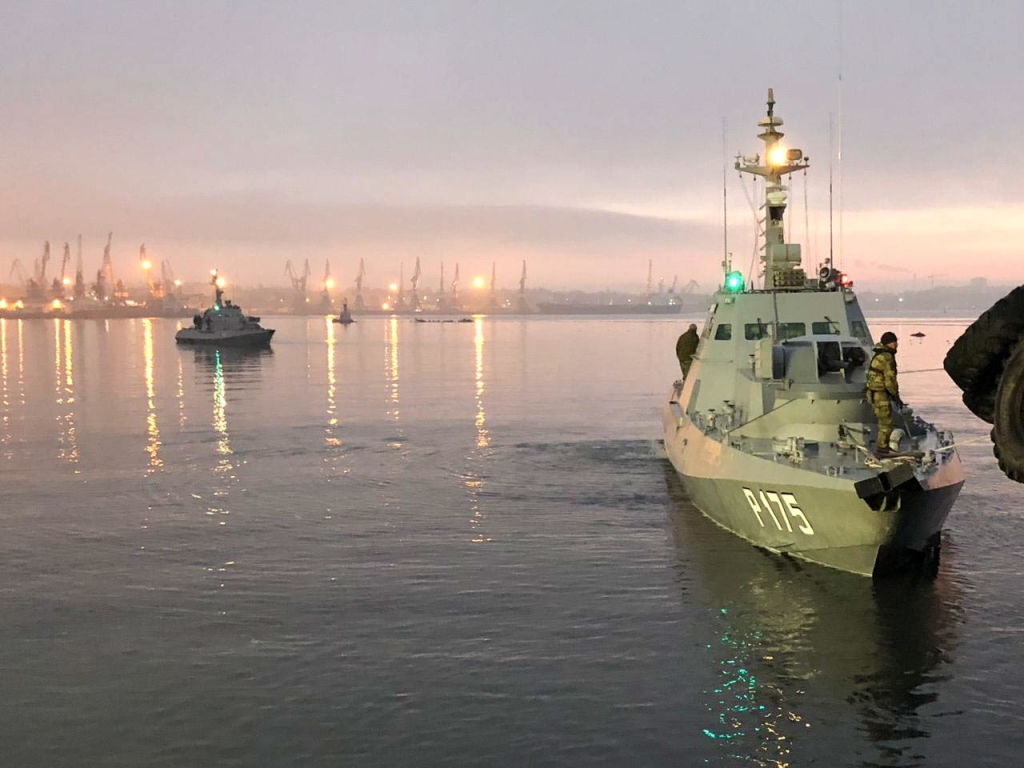
Had anybody ever heard of the Sea of Azov? It is a very shallow inland sea not even the size of Lake Michigan, tucked away in a northern corner of the far larger Black Sea. But over the past few days, it has become the site of a dramatic at-sea conflict between Russia and Ukraine.
On Nov. 25, Russian warships in the Sea of Azov carrying Spetznatz — the Russian equivalent of U.S. Navy SEALS — seized two Ukrainian gunboats and a tug, wounding half-a-dozen sailors, the Ukrainian navy has reported. The Russians impounded the sovereign warships and detained nearly 30 sailors, and a Kremlin spokesman has told state media that they are investigating the supposed Ukrainian incursion into their claimed territorial waters.
All of this flows from the invasion of Ukraine by Russia in 2014 that led to Russia’s illegal annexation of the Crimean Peninsula, which comprises much of the southwestern edge of the Sea of Azov, and the ongoing occupation of southeastern Ukraine by rebel forces supported by Russian troops and special forces. Look at the map — to truly consolidate the annexation of Crimea, Russia needs totally secure communications from the Russian mainland to the peninsula. The best way to accomplish that is to control the highly strategic Strait of Kerch, the narrow waterway between the Black Sea and the Sea of Azov.
For the Trump Administration, though, this will be another testing point in its notably odd relationship with Russia — just as President Trump prepares for a summit with Vladimir Putin at this week’s G20 meeting.
On the one hand, the President’s team (especially Secretary of Defense Jim Mattis and National Security Advisor John Bolton) have taken a strong stand against Russian bad behavior, particularly the annexation of Crimean. The U.S. has correctly led the imposition of economic sanctions that have had a serious impact on the Russian economy. They have also led the charge against Russia’s repeated violations of the INF treaty, as well as the Russian military’s dangerous operational practices against NATO warships and jets.
But after before, during and after the President’s disastrous mid-summer Helsinki press conference beside Putin, Trump has given Russia a pass on its disruptive behavior internationally. This dissonance must end. And the upcoming summit provides an essential opportunity to correct Trump’s stance, both in the President’s private high-level meetings, and in public.
Russian behavior in Ukraine is clearly illegal under international law. In particular, the President must make clear that the annexation of Crimea is a crime, and that sanctions will continue until Russia modifies its stance and chooses to work with the international community to resolve the situation through the process determined by the Minsk Protocol in 2014. Allowing a frozen conflict, like Georgia and Moldovia (both essentially occupied by Russia), is untenable — Ukraine is too large, important and nationalistic to permit a long-term annexation of a further chunk of their state. The President must show zero daylight between the U.S. and our NATO and European allies on this issue, or Putin will exploit the seams to continue toward achieving his ultimate strategic goal of unraveling the trans-Atlantic alliance.
The President must also strongly affirm U.S. support for Ukraine in every dimension, including providing them with capable defensive armament. The Obama Administration dithered unnecessarily on this, emboldening Russia, and the Trump national security team has been appropriately strong on this point. In addition to anti-air tactical systems, ammunition, radars, communications devices and the like, America should also provide appropriate levels of training and advising, using NATO as a vehicle to do so.
Speaking of: NATO-Ukraine cooperation has an important role to play in this situation. It can provide a reassuring sounding board for the Ukrainians, who are understandably moving toward a war footing. President Petro Poroshenko has successfully declared martial law for 30 days and energized his defense establishment. He clearly sees the Russian moves as a potential thrust to fully consolidate control over the Donbass region in the southeast of Ukraine. Putin may be calculating that, with the Mueller investigation in the U.S. coming to a head, the President and his team will be distracted as the year concludes and the holiday season beckons. This gives us all the more reason to make NATO the centerpiece, and to not make this a U.S.-Russian confrontation, which will better protect all we’ve gained.
Most of all, the President ought to make the point that it is in no one’s interest to stumble backward into a full-blown Cold War, let alone have an actual war inside Ukraine. Perhaps by appealing to Putin’s pragmatic side, we can defuse this crisis before it spirals into something we cannot control.
So many wars have begun with seemingly small actions at sea, where decisionmakers incorrectly assume the stakes are lower because land territory isn’t immediately involved. The lesson of the Gulf of Tonkin is unfortunately instructive here. Nobody had heard of that body of water either — until it pulled the United States into the war in Vietnam.
More Must-Reads from TIME
- Why Trump’s Message Worked on Latino Men
- What Trump’s Win Could Mean for Housing
- The 100 Must-Read Books of 2024
- Sleep Doctors Share the 1 Tip That’s Changed Their Lives
- Column: Let’s Bring Back Romance
- What It’s Like to Have Long COVID As a Kid
- FX’s Say Nothing Is the Must-Watch Political Thriller of 2024
- Merle Bombardieri Is Helping People Make the Baby Decision
Contact us at letters@time.com